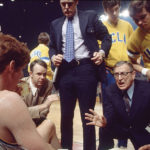It was just back pain. That’s what Boston Red Sox pitcher Jon Lester kept telling himself. When you throw like a 25-year-old left-hander does, muscles are often sore—but the pain wouldn’t go away.
Lester went to see doctors and heard words he never expected: He had cancer. It wasn’t just any form of the disease, but a rare form of blood cancer known as anaplastic large-cell lymphoma. To beat back the cancer’s spread, Lester would require intensive chemotherapy.
“I didn’t once ask why,” Lester tells SUCCESS. “Instead, I asked how we get rid of this. I wanted to think positively and look forward.”
With that approach, Lester became a hero to many. After receiving his diagnosis in August 2006, Lester went through treatment, worked his way back into the major leagues and pitched—and won—a World Series game. Then, in May 2008, he became the 18th pitcher in the history of the storied Red Sox organization to throw a perfect game.
As of 2009, Lester is cancer-free.
“I don’t think I had any idea what it would mean to others when I made it back,” Lester says. “I was just trying to win each day, to make sure I was doing whatever it took to be as disciplined and successful in treatment as I was in baseball.”
By doing so, Lester earned a legion of new fans, many of them cancer survivors. Websites were loaded with letters of thanks and words of encouragement. Many of those writing wanted Lester to know his top-flight accomplishment gave them a reason to believe. “I was surprised, honestly,” he says. “There were so many things said that were wonderful, but all I was trying to do was make my way back.”
Lester is one of many athletes who have handled adversity on a grand stage and have used the same strengths that made them champions to get them through tough times.
Reclaiming his mastery
Famous for his stringent discipline in practice, Ben Hogan was one of the premier golfers of the 1940s when his career—and his life—nearly ended in a head-on collision with a Greyhound bus. The 1949 accident left him with a fractured collarbone and ankle, a double-fractured pelvis, blood clots and a cracked rib. It also left him with the burning desire to fight back.
Less than a year after doctors told him he’d never walk again, Hogan placed second in the 1950 Los Angeles Open tournament, losing to Sam Snead in a tightly-fought playoff round. Six months after that, he clinched the U.S. Open title for the second time in his career. In 1951, he won the U.S. Open—for the third time—and the Masters. In 1953, he won both again.
Widely regarded as one of the greatest golfers of all time, Hogan won a total of 71 professional tournaments over the course of his career.
By refusing to allow the tragedy of his accident to define him, Hogan instead invested himself in chasing his dream. His rigorous and dedicated practice habits were no longer just about honing a skill—they were about reclaiming a part of himself. Despite the odds against him, Hogan never turned down an opportunity to study his game. “Every day you miss practicing,” he said, “will take you one day longer to get good.”
Fastest woman on earth
Hogan’s example was cited several times by a 20-year-old American track sensation, Wilma Rudolph, who captured the title of “the fastest woman on earth” at the 1960 Olympics.
Rudolph could hardly have had a less promising start. Born prematurely and struck by polio as an infant, tiny Rudolph limped through a childhood marred by measles, scarlet fever, whooping cough and a twisted left leg that required a brace. But none of that could contain her spirit. Fascinated by her older sister’s basketball games, Rudolph was determined to take to the court herself and fought her way through painful rehabilitation and physical therapy.
As a high-school player, she caught the eye of the Tennessee State track and field coach, who recognized her tremendous ability and began training her as a runner. At 16, she made the U.S. Olympic team in 1956, winning bronze in the 4×100 relay. Four years later, she truly made her mark, winning gold in the 100-meter dash, 200-meter dash and as part of the 4×100-meter relay team, breaking three world records. And this from a woman who wasn’t able to walk normally until she was nearly 12.
For Rudolph, the goal was everything. Any obstacles on the way were part of the journey toward greatness. Challenges, restraints, setbacks—these were all things to push against to grow stronger. Her winning mindset was simple: “The triumph can’t be had without the struggle.”
Seeing beyond limitations
And as proof that athletes often find inspiration from each other, Lester, after working his way back into the major leagues, regularly mentioned pitcher Jim Abbott when he described where he looked for inspiration.
Abbott didn’t suffer disease, but he was no stranger to challenges. The 10-season major league pitcher was born without a right hand. Never one to let a perceived disability stand in the way of his goals, he pursued athletics with his heart and soul. As a high-school quarterback leading his football team to a Michigan state championship, he developed a distinct pitching and fielding style that made him a highly sought-after baseball recruit.
Despite being drafted out of high school, however, Abbott decided instead to attend the University of Michigan, where he led the Wolverines’ baseball program to two Big Ten Conference championships and became the first baseball pitcher to earn the James E. Sullivan Award for the best amateur athlete in the country. In 1988, he earned a gold medal pitching the final game at the Seoul Olympics.
From there, he was drafted, eighth overall, by the Angels. In 1993, playing for the Yankees, he pitched a 4-0 no-hitter against the Cleveland Indians. Abbott’s story quickly became one of the most inspiring in professional athletics, encouraging children to look past their limitations and keep their eyes on their dreams.
“I’ve learned that it’s not the disability that defines you,” Abbott explains. “It’s how you deal with the challenges the disability presents you with.”
‘Be everything you want to be’
Natalie du Toit would have been a perfect candidate for Abbott’s mentoring. Already an internationally-ranked swimmer in her native South Africa by the age of 14, du Toit seemed to be a rising star in international athletics. But just three years later, in 2001, she was struck by a car on her way back to school from swim practice, and lost her left leg at the knee as a result.
The very next year, she took to the pool at the 2002 Commonwealth Games and won not only two events for athletes with physical challenges, but also became the first amputee athlete to qualify for the final of a regular event when she swam the 800-meter freestyle. In 2003, again swimming the 800-meter freestyle, she won gold at the All-Africa Games.
She continued to wow the swimming world, winning or placing in nearly every international competition she entered, including winning five golds and one silver in the Paralympics and two golds again in the 2006 Commonwealth Games—and all without the aid of a prosthetic leg.
When she qualified for the 2008 Beijing Olympics, du Toit was honored in another way: She became the first physically challenged athlete to carry a country’s flag in the opening ceremony. Her 16th-place finish in the 10-kilometer open-water swim was not as strong a finish as she had hoped, but in a field of 23 other athletes, all able-bodied, it was a triumph indeed.
“Be everything you want to be,” du Toit regularly reminds her fans during interviews. Clearly, she is a tremendous reminder that no obstacle is too great that it cannot be challenged—and overcome.
This article was published in June 2009 and has been updated. Photo by Dennis Ku/Shutterstock








